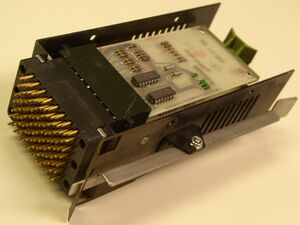Difference between revisions of "DIA20 IBus Adapter"
(An OK start) |
(+img of IBus conn) |
||
| Line 2: | Line 2: | ||
==Implementation== | ==Implementation== | ||
| + | |||
| + | [[Image:KIKLIOBusTerm.jpg|300px|right|thumb|IBus [[terminator]]]] | ||
The DIA20 is connected to the EBox of the KL10 via the EBus; when no other controller on the EBus responds to a command, the DIA20 will respond, and send the command out the IBus. Similarly, [[interrupt]] requests from IBus devices are sent through to the EBox. | The DIA20 is connected to the EBox of the KL10 via the EBus; when no other controller on the EBus responds to a command, the DIA20 will respond, and send the command out the IBus. Similarly, [[interrupt]] requests from IBus devices are sent through to the EBox. | ||
| − | It consists of a number of [[DEC card form factor|hex]] boards (two M8550s and an M8551) plugged into an I/O [[backplane]] (one shared with the [[DMA20 Memory Bus | + | It consists of a number of [[DEC card form factor|hex]] boards (two M8550s and an M8551) plugged into an I/O [[backplane]] (one shared with the [[DMA20 Memory Bus Adapter]]) of the KL10; these are connected to new-style I/O bus connectors mounted lower down in that rack. |
==External links== | ==External links== | ||
Revision as of 22:31, 12 October 2021
The DIA20 IBus Adapter (sometimes called the DIA20 In/Out Bus Controller) is an optional controller on KL10 CPUs which provides an old-style PDP-10 I/O bus (termed an 'IBus'), to allow existing PDP-10 peripherals to be used on one. Two separate IBuses are provided per CPU. (In a multi-processor system, each CPU has a separate DIA20, if configured to have one.)
Implementation

The DIA20 is connected to the EBox of the KL10 via the EBus; when no other controller on the EBus responds to a command, the DIA20 will respond, and send the command out the IBus. Similarly, interrupt requests from IBus devices are sent through to the EBox.
It consists of a number of hex boards (two M8550s and an M8551) plugged into an I/O backplane (one shared with the DMA20 Memory Bus Adapter) of the KL10; these are connected to new-style I/O bus connectors mounted lower down in that rack.
External links
- DIA20 IBus Adapter Unit Description
- KL10-Based Physical Description - contains images of DIA20 backplanes and wiring, pp. 3-7-3-11; board configuration, pp. 3-27,3-28